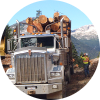Bella Coola is surrounded by an awe inspiring and majestic landscape that defines the character of the Bella Coola valley community and it is the source for the community’s socioeconomic wellbeing. Therefore, Bella Coola’s sustainability is fundamentally tied to the sustainability of the surrounding forest. Through the Community Forest, the community becomes the steward of the land and in its own self interest will work to assure a healthy forest environment is sustained.

Seedling
Sustainable forestry means harvesting at the rate that the forest regrows. To determine the sustainable harvest rate for the community forest, it starts with the forest inventory which contains information such as tree species, age, height, volume and site productivity. With such a mountainous land base, most of the productive forest is not accessible or feasible to operate on and so the timber harvesting land base (THLB), or the working forest, needs to be identified. This includes a series of land net downs to remove key habitat for grizzly bears, riparian forest to protect streams, mountain goat and deer winter range that are not available for harvesting. After these and many other net downs are removed the THLB is the remainder and this is the land base that is harvested over a period equivalent to the time it takes a tree to grow to harvestable size, otherwise known as the rotation age. The Bella Coola Community Forest contains 24,270 ha of productive forest, but the net THLB is only 9,270 ha, or 38% of the productive forest. Based on the growth rate on the THLB, the annual allowable cut (AAC) is set at 30,000 m3/year.
Setting a sustainable rate of harvest, assures that there will always be timber available to be cut, thus providing opportunity for sustainable economic activity. But sustainability also means that a healthy forest environment is maintained and this is assured through the comprehensive Provincial system of forest management required through the Forest and Range Practices Act and associated regulations. This legislation requires that forest tenures operate under an approved Forest Stewardship Plan (FSP). This legal plan, sets out requirements for protection of forest soil, old growth representation, keystone wildlife habitat, water quality, fish habitat, biodiversity, cultural and heritage resources and visual impact.
With the combination of sustainable rate of harvest and the comprehensive system of environmental protection, management of the community forest assures its own sustainability, which will help sustain the community while the surrounding forest environment is maintained in a healthy condition.



